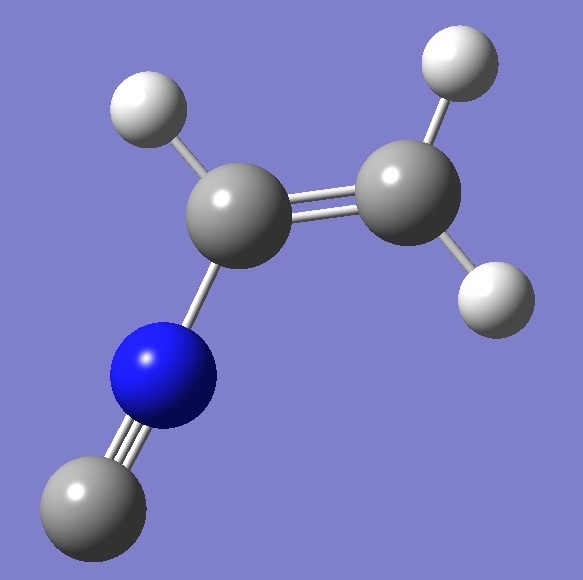|
|
|
|
|
|
|
|
|
|
|
|
|
|
|
|
|
|
|
|
|
CH2CHNC |
|
|

|
|
|
|
|
|
|
|
|
|
|
|
|
|
|
|
|
|
|
|
|
Nitrogen
|
|
|
Nuclear
Quadrupole Coupling Constants |
|
|
|
in
Vinyl Isocyanide |
|
|
|
|
|
|
|
|
|
|
|
|
|
|
|
|
|
|
|
|
|
|
|
|
|
|
|
|
|
|
|
|
|
Calculation of the nitrogen nqcc's in
vinyl isocyanide was made on a structure obtained by B3P86/6-31G(3d,3p)
optimization, and on the heavy atom substitution structure of Chang et
al. [1]. These are compared in Table 1 with the experimental
nqcc's of Bestman and Dreizler [2]. Structure parameters are
given in Table 2. |
|
|
|
|
|
|
|
|
|
|
|
|
In Table 1, subscripts a,b,c refer to
the
principal axes of the inertia tensor; x,y,z to the principal axes
of the nqcc tensor. The nqcc y-axis is chosen coincident with the
inertia c-axis, these are perpendicular to the molecular plane.
Ø (degrees) is the angle between its subscripted
parameters. ETA = (Xxx - Xyy)/Xzz. |
|
|
RMS is the root mean square
difference between calculated and experimental diagonal nqcc's
(percentage of the average of the magnitudes of the experimental
nqcc's). RSD is the calibration residual standard deviation of
the B3PW91/6-311+G(df,pd) model for calculation of the nitrogen efg's/nqcc's. |
|
|
|
|
|
|
|
|
|
|
|
|
|
|
|
|
|
|
|
|
|
|
| |
|
|
|
|
|
|
|
|
|
Table 1. 14N nqcc's in CH2CHNC
(MHz). Calculation was made on (1) B3P86/6-31G(3d,3p)
optimized structure, and (2) the substitution structure of Chang et al.
[1] |
|
| |
|
|
|
|
|
|
|
|
|
|
|
Calc (1) |
|
Calc (2) |
|
Expt. [2] |
|
| |
|
|
|
|
|
|
|
|
|
Xaa |
|
0.259 |
|
0.270 |
|
0.258(5) |
|
|
Xbb |
- |
0.294 |
- |
0.301 |
- |
0.258(6) |
|
|
Xcc |
|
0.035 |
|
0.031 |
- |
0.000(6) |
|
|
|Xab| |
|
0.317 |
|
0.316 |
|
|
|
|
|
|
|
|
|
|
|
|
|
RMS |
|
0.029 (17 %) |
|
0.031 (18 %) |
|
|
|
|
RSD |
|
0.030 (1.3 %) |
|
0.030 (1.3 %) |
|
|
|
|
|
|
|
|
|
|
|
|
|
Xxx |
-
|
0.435
|
-
|
0.442
|
|
|
|
|
Xyy |
|
0.035 |
|
0.031 |
|
|
|
|
Xzz |
|
0.403 |
|
0.411 |
|
|
|
|
ETA |
- |
1.166 |
- |
1.151 |
|
|
|
|
Øz,a |
|
24.46 |
|
23.97 |
|
|
|
|
Øa,NC |
|
15.06 |
|
15.72 |
|
|
|
|
Øz,NC |
|
9.40 |
|
8.25 |
|
|
|
|
|
|
|
|
|
|
|
|
|
|
|
|
|
|
|
|
|
|
|
|
|
| |
|
|
|
| Table 2. Molecular
structure parameters: ropt = B3P86/6-31G(3d,3p); and heavy
atom rs [1] with CH geometry given by partial optimization
at MP2/6-31G(d,p) level where r(CH) = 1.001 x MP2/6-31G(d,p) optimized
bond length [3] (Å
and degrees). |
| |
|
|
|
|
|
ropt |
rs |
|
|
|
|
|
CN |
1.1755 |
1.174(6) |
|
NC(1) |
1.3746 |
1.379(6) |
|
C(1)=C(2) |
1.3296 |
1.338(4) |
|
C(1)H |
1.0850 |
1.082 |
|
C(2)Hc |
1.0833 |
1.080 |
|
C(2)Ht |
1.0824 |
1.079 |
|
CNC |
177.59 |
178.2(12) |
|
NCH |
114.27 |
114.68 |
|
NC=C |
123.13 |
122.5(7) |
|
C(1)=C(2)Ht |
119.75 |
119.77 |
|
C(1)=C(2)Hc |
121.65 |
121.47 |
|
|
|
|
|
|
|
|
|
|
|
|
|
|
|
|
|
|
|
|
|
|
|
[1] Te-an Chang, M.D.Harmony, and
S.W.Staley, J.Mol.Struct. 190,17(1988). |
|
|
[2] G.Bestmann and H.Dreizler,
Z.Naturforsch. 37a,58(1982). |
|
|
[3] J.Demaison and G.Wlodarczak,
Struct.Chem. 5,57(1994). |
|
|
|
|
|
|
|
|
|
|
|
|
|
|
|
|
|
|
|
|
|
|
CH3CH2NC |
CH3NC |
CF3NC |
HCCNC |
|
|
(CH3)3CNC |
C6H5NC |
CNCN |
HNC |
|
|
|
|
|
|
|
|
|
|
|
|
|
|
|
|
|
|
|
|
|
|
Table of Contents |
|
|
|
|
|
Molecules/Nitrogen |
|
|
|
|
|
|
|
|
|
|
|
|
|
|
|
|
|
|
|
|
|
|
|
|
|
|
|
|
|
|
CH2CHNC.html |
|
|
|
|
|
|
Last
Modified 13 Oct 2009 |
|
|
|
|
|
|
|
|
|
|
